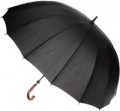The material from which the umbrella frame is made. The frame in this case means mainly the central rod, however, the spokes are often made of the same material — unless otherwise indicated in the characteristics (see "Spoke material").
—
Steel. One of the most popular options among modern umbrellas. Steel allows you to provide good indicators of strength and elasticity. It is worth noting that different types and grades of this material can be used in umbrellas, so the actual characteristics of a particular steel frame are directly related to the price category of the product. However, steel is used even in high-end premium models. Of its "global" shortcomings, one can only note a rather large weight.
—
Aluminium. Aluminium alloys used in umbrellas are noticeably lighter than steel, but less durable. They can also have different characteristics, usually directly related to the price category of the respective model, however, in general, this material is considered less reliable, and therefore is found mainly in entry-level and mid-level umbrellas.
—
Fiberglass. Material based on glass drawn into thin threads. It has little in common with ordinary window glass: it is highly durable, does not break, and bends well without damage. Actually, flexibility is one of the main advantages of fiberglass — it is this material that is often used in
storm umbrellas(see above), because. such knitting needles easily endure repeated turning inside out and back.
—
Fiberglass. A polymeric material combining the fiberglass described above with a plastic base. It costs much less than pure fiberglass, but loses to it in terms of performance, which is why it is found mainly in inexpensive models of umbrellas.
— CFRP. A composite material that combines fine carbon fiber fabric and a plastic base. Differs in extreme durability — some grades surpass even steel — at the same time it weighs very little; on the other hand, the cost of CFRP is quite high. As a result of all this, this material is used quite rarely in umbrellas, mainly among luxury products.
—
Tree. Wood has a pleasant appearance, but is inferior to metal in strength. Therefore, it is used mainly as a design material in some cane umbrellas (see "Type") — and even then in such models only the central rod is usually made of wood, the rest of the parts are made of metal.
— Plastic. Pure plastic is poorly suited for the manufacture of frames for umbrellas: it is not strong enough and resistant to stress for this. Therefore, this option can only be found in the most inexpensive models, as well as in children's umbrellas (see "Purpose"), for which light weight and the absence of sharp edges are more important than high strength.
Note that some models can be equipped with combined frames: for example, the central rod is made of steel, and the spokes are made of fiberglass. This is usually indicated in the specifications.
The diameter of the umbrella dome when unfolded. The larger the diameter of the dome, the more reliably it will protect you from rain and the easier it will be to place one more person under the umbrella. On the other hand, a wide umbrella can be uncomfortable in tight spaces — for example, in the flow of pedestrians on a busy street — and when folded it will take up more space. Therefore, it does not always make sense to choose the largest of the available options.
The minimum diameter for an "adult" umbrella (see "Destination") is considered to be about 80 cm. Most models are in the range of 90 – 110 cm — this provides a good degree of protection with ease of movement. And in
the largest modern products, the diameter of the dome can reach 150 cm.
The length of the umbrella when folded. For the decomposed one, this parameter is not specified, because is not critical, but when transporting a closed umbrella, it is the length that is the most important dimension.
The length of cane umbrellas (see "Type") is, by definition, the same when open or closed; most often it is 60 – 90% of the dome diameter (see above). But folding models of the same diameter can vary markedly in length, and here the choice depends on the situation: on the one hand, more compact umbrellas are more convenient to carry, on the other hand, they are less reliable and more complex in design, and also cost more.
Total weight of the umbrella.
All other things being equal,
lighter umbrellas are more convenient to carry (both in the open and closed positions). On the other hand, such products are less reliable and/or more expensive than relatively heavy models of similar design and size. We also note that in some cases, significant weight can be an advantage. For example, in a strong wind, a massive umbrella does not “tear from your hands” as much, and when released, it does not fly as far as a lighter one.

